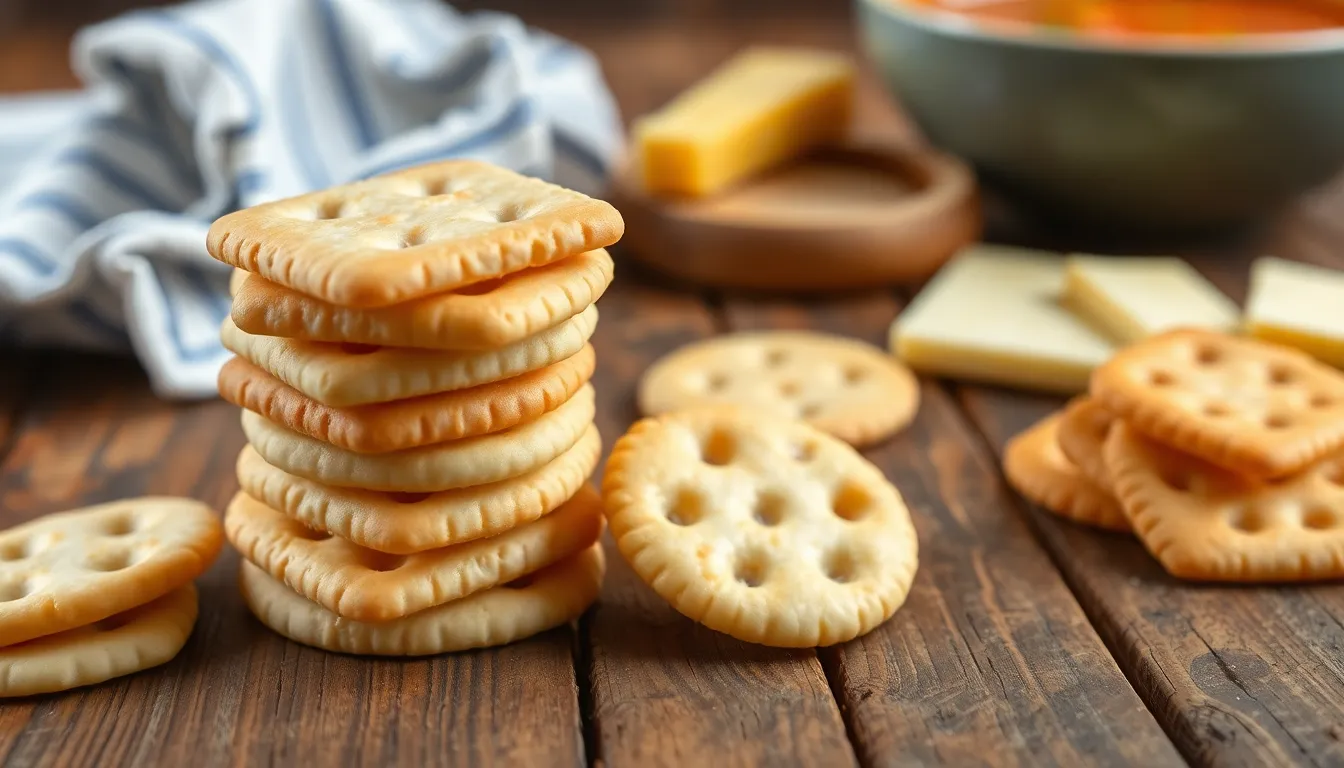Saltine crackers are a staple in many households, often enjoyed for their light and crispy texture. They’re versatile snacks, perfect for pairing with soups, cheeses, or simply on their own. But how many calories are packed into these seemingly innocent bites? Understanding the calorie content can help individuals make informed choices about their snacking habits.
In a world where dietary awareness is on the rise, knowing the nutritional value of everyday foods is essential. Saltine crackers may seem harmless, but their calorie count can add up quickly, especially when eaten in larger quantities. This article delves into the specifics of calories in a saltine cracker, offering insights into their nutritional profile and how they fit into a balanced diet.
Table of Contents
ToggleOverview of Saltine Crackers
Saltine crackers serve as a popular snack choice due to their light, crispy texture and versatility. They often accompany soups, cheeses, and various dips, making them a staple in many households.
What Are Saltine Crackers?
Saltine crackers, also known as soda crackers, consist of an enriched flour base, water, and salt. They undergo a baking process that results in a light, airy, and crisp texture. Their unique characteristic includes a distinct salt topping, providing flavor and enhancing their appeal. Commonly packaged in boxes or sleeves, these crackers offer easy accessibility and convenience for snacking.
Nutritional Profile
The nutritional profile of saltine crackers typically includes essential components. A standard serving of saltine crackers (approximately 5 crackers or 15 grams) contains:
| Nutrient | Value per Serving |
|---|---|
| Calories | 60 |
| Total Fat | 1 g |
| Saturated Fat | 0 g |
| Cholesterol | 0 mg |
| Sodium | 110 mg |
| Total Carbohydrates | 12 g |
| Dietary Fiber | 0 g |
| Sugars | 0 g |
| Protein | 1 g |
These figures illustrate the relatively low-calorie content of saltine crackers. However, their sodium content may warrant attention for those monitoring salt intake. Despite minimal nutritional value, the crackers remain a convenient option for quick snacking or pairing with other foods.
Calories in a Saltine Cracker

Saltine crackers are known for their low-calorie count, making them a common choice for light snacking. Understanding their caloric content helps individuals make informed dietary decisions.
Breakdown of Caloric Content
A standard serving of saltine crackers, approximately 5 crackers or 15 grams, contains the following nutritional values:
| Nutrient | Amount |
|---|---|
| Calories | 60 |
| Total Fat | 1 gram |
| Sodium | 110 mg |
| Carbohydrates | 12 grams |
| Protein | 1 gram |
Saltine crackers provide minimal nutritional benefits and are primarily composed of carbohydrates and sodium. The low fat content, combined with the moderate sodium level, is notable for individuals with specific dietary restrictions.
Comparison with Other Crackers
Saltine crackers contain fewer calories compared to many other types of crackers, such as:
- Whole Wheat Crackers: Approx. 80-100 calories per serving
- Cheese Crackers: Approx. 150-200 calories per serving
- Rye Crackers: Approx. 90-120 calories per serving
This lower calorie content makes saltine crackers a suitable option for those seeking lighter snacks. However, their higher sodium level, compared to some plain varieties, may warrant attention for health-conscious consumers.
Health Considerations
Understanding the health implications of consuming saltine crackers is crucial for making informed dietary choices. In particular, portion control and the low nutritional value of these snacks warrant attention.
Portion Control and Serving Sizes
Portion control plays a significant role in managing calorie intake and sodium consumption. A standard serving of saltine crackers consists of approximately 5 crackers, equating to 15 grams and containing 60 calories. When eaten in moderation, saltine crackers can fit into a balanced diet. However, it’s essential to avoid overindulging, as intake can quickly escalate beyond recommended limits. For example, consuming one serving of 5 crackers, compared to two servings, doubles calorie intake to 120 calories and increases sodium intake from 110 mg to 220 mg. Readers should consider their overall dietary goals when snacking on saltine crackers.
Impact on Diet and Nutrition
Saltine crackers primarily consist of carbohydrates and sodium, offering minimal nutritional benefits. While their low-calorie count may appeal to those seeking light snacks, the high sodium content, at 110 mg per serving, poses risks, particularly for individuals monitoring their salt intake due to hypertension or other health concerns. Comparatively, whole wheat or cheese crackers might provide more nutrients, though with a higher caloric value ranging from 80 to 200 calories per serving. The lack of fiber, protein, or essential vitamins in saltine crackers highlights the importance of pairing them with nutrient-rich foods such as fruits or vegetables, enhancing their overall dietary contribution.
Variations and Alternatives
Several variations and alternatives to traditional saltine crackers cater to different dietary preferences and health concerns.
Whole Grain and Low-Sodium Options
Whole grain saltine crackers offer higher nutritional value than standard versions. They contain more fiber, providing digestive benefits and enhanced satiety. Low-sodium alternatives are available for those monitoring their salt intake, offering a similar flavor profile without the excessive sodium content, making them ideal for individuals with hypertension or other health issues.
Homemade Saltine Crackers
Homemade saltine crackers present an opportunity for customization regarding ingredients and nutrition. By using whole grain flour, healthier fats, or herbs and spices, they can enhance flavor and boost nutritional content. Recipes commonly include simple ingredients like flour, water, salt, and a pinch of baking powder. Homemade versions allow for control over sodium levels and can be a more wholesome option than store-bought varieties, aligning better with individual dietary needs.
Saltine crackers can be a convenient and low-calorie snack option for many. Their light texture and versatility make them a popular choice in various culinary contexts. However it’s essential to be mindful of their sodium content and minimal nutritional value.
For those looking to enjoy saltine crackers while maintaining a balanced diet pairing them with healthier options can enhance their overall contribution to nutrition. Exploring alternatives like whole grain or low-sodium varieties can also provide better dietary benefits without sacrificing flavor.
Ultimately understanding the calorie content and health implications of saltine crackers allows individuals to make informed choices that suit their dietary needs.




